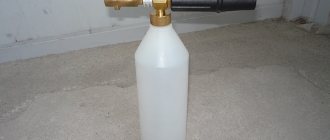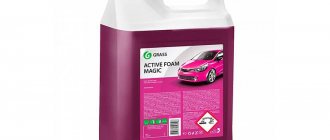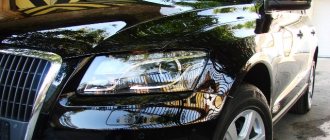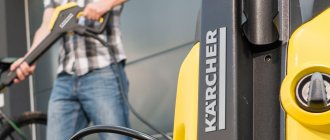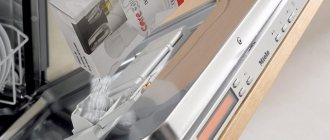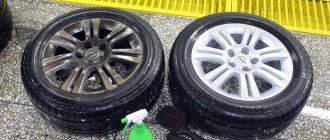In this article, we will take a closer look at how to wash a car with a pressure washer. Pressure washing makes car washing easier, faster and more efficient. It will easily remove dirt inside the arches, on the lower part of the sills and the bottom, which is difficult to do manually. You will spend less water washing your car. The pressure washer is connected to a water source through a regular hose. A powerful motor operates a pump that pumps water and sprays it through a special nozzle with high pressure. Reduces water consumption by up to 80% compared to washing with a hose.
Safety precautions
- Using a high pressure washer requires compliance with safety precautions. Don't forget that this is not just a garden hose with a nozzle. Water comes out of the washer nozzle with 30 to 80 times more pressure than from a hose. It must be remembered that high pressure washing is quite dangerous if used incorrectly. You need to be especially careful when using nozzles that produce a narrow or pinpoint stream of water. Start working 60 cm from the surface, move no closer than 15–30 cm.
- Spraying with a wide spray is safe for both humans and the car’s paintwork. This will take longer to remove individual stubborn stains than a spot spray or narrow spray, but will reduce the risk of damage.
- If there is a power line nearby, you must maintain a distance of at least 2 meters from it.
- Do not use the washer if you are standing on a hill. Pulling the trigger may cause kickback and fall.
- Do not point the pressurized water nozzle at people or animals. Strong water flow can cause serious damage to the skin.
Is it possible to “kill” a motor by washing?
If the high-pressure washing technology is violated, then:
- the car will not start;
- the engine will start, but immediately stall;
- some electrical appliances will stop working;
- unstable engine operation is observed;
- there are dips when pressing the gas;
- no traction.
The main troubles will affect the electronics , since the mechanical part is protected from water penetration. Some signs will appear only after a certain period of time, for example, this concerns the oxidation of contacts.
If most problems in the operation of an internal combustion engine can be eliminated by getting water on the spark plug wells by drying the contacts of the distributor, then if the electronic control unit fails, you will have to invest a lot of money in its repair. Therefore, before washing the car, you should carefully prepare it.
How to prepare a high pressure washer for use
- When using an extension cord, always unwind it. The extension cord must have a cable thick enough to withstand the load imposed by the pressure washer.
- Do not use hot water with a pressure washer. Hot water can damage the rubber seals and the washer pump. The water can be warm, but should not exceed 60 degrees.
- When using a high pressure washer, there may be a lack of water, which will lead to pump failure. This is especially true with more powerful sinks that require a larger amount of continuous water flow. If the water source provides only the minimum required amount of water, then so-called cavitation (the formation of a mixture of air and water bubbles) inside the pump may occur, which may not be immediately noticed or noticed too late. Thus, the pump may fail. To make sure that the water source provides the required volume, you need to fill a bucket with a scale divided into liters per minute. This way you can calculate how much water will flow to the sink.
- Connect the hose from the water source to the sink.
- Make sure all connections are secure.
- Run water through the connected hose. The water pressure should not exceed 5 bar. Make sure the water reaches the sink. Without water, a working sink can quickly fail.
- Before turning on the washer, pull the spray gun trigger for a few seconds to bleed air from the system and relieve any remaining pressure. It is very important to run water through the sink so that it flows through the gun when the trigger is pulled. This must be done before turning on the sink, within one minute. This way, any air is released from the system before using the washer.
- Continue pressing the trigger and turn on the washer.
How to properly wash a car under the hood
Before you start washing the engine, you need to remove decorative and protective screens, plastic elements, and disconnect the wiring . Cover the tanks and body parts with inscriptions and plates; waterproof material is suitable for this.
Close with polyethylene and tape:
- electrical equipment parts;
- terminals;
- connectors;
- air intakes.
It is advisable to remove the battery . You cannot start washing the engine while it is still hot, the chemical composition will evaporate quickly and the result will not be visible. The engine temperature should be 40-50 degrees.
Before the procedure, be sure to remove dry leaves so that they do not fall into the drainage holes. Coat the motor with a special compound and wait the prescribed time. There is no need to apply foam liquid liberally; it will take a long time to rinse off, which poses a danger to electrical wiring. The engine must be flushed gently so as not to damage plastic and rubber parts and wiring. It is better to wash the engine in warm weather. In cold weather, water may remain on the moving parts, this will negatively affect the condition and operation of the engine. Drying is necessary after washing .
A high pressure washer is also used to wash the engine.
How to wash with a high pressure washer?
- Before washing your car, make sure all windows are tightly closed.
- Washing with water under pressure is carried out in the same order as when using a hose and washing sponges and mittens, from top to bottom (when applying foam from bottom to top).
- The initial trigger pull of the spray gun may produce a stream of water with excessive pressure exceeding the operating pressure. For this reason, when you first pull the trigger, you should point the spray nozzle away from the vehicle. A sharp flow with high pressure can damage the paintwork or plastic of the headlight.
- It is recommended to apply the foam to a dry surface. A wet surface will dilute the foam and reduce its effectiveness. Therefore, if the car is not very dirty, then the foam can be applied immediately. However, if there is a thick layer of dirt, it is better to first rinse the machine using a wide or medium torch and high water pressure to wash away dirt, salt and sand.
- You need to start at a distance of at least 50 cm from the surface and move no closer than 15–30 cm, at an angle of 25–45 degrees, so that dirt does not affect the paintwork.
- After the car is free of major dirt, apply detergent. To apply foam, a special foam nozzle is used. We will look at the effect of foam and the subtleties of its application in more detail below. Use only a product that is approved for use with a pressure washer. On vertical surfaces, apply foam from bottom to top. This way it will hold on better and not slide off ahead of time.
- Wait a few minutes for the product to take effect. Next, after 3-5 minutes, wash off the foam with water with a wide jet and high pressure. Maintain a distance of at least 30 cm from the surface. The product will weaken the most difficult to remove stains and oil stains.
- You should always hold the nozzle at an angle to the surface, ideally at an angle pointing downwards. This way, dirt and foam will not be splashed onto the newly washed surface. Spraying at an angle to the surface (25–45 degrees), as already mentioned, avoids scratches from washed-off solid contaminants.
- Depending on the degree of contamination of the car, applying and rinsing off foam may be sufficient, or further hand washing with a special microfiber mitt or sponge with or without car shampoo may be required.
To wash the car, a special brush can be used, which is attached to the spray gun. If you use the same brush for the wheels and for the body, then wash the wheels last so that abrasive from the pads or a small stone does not get on the body.- A lot of dirt and salt stick to the bottom, so don't forget to wash it. Use a special lance for this purpose, spraying at an angle. When using the underbody cleaning attachment (optional), always rest it firmly on the floor to avoid kickback and rotation.
- The final rinse can be done by removing the high pressure nozzle completely.
Operating instructions for the Kärcher mini-washer
There is an opinion among Internet users that before you start using a mini-wash, you will first need to clean the entire surface of the body from dirt with a dry cloth. Such judgments are made by ignorant people. Don't make these mistakes. Karcher is a contactless way to wash your car.
Shampoo dissolved in water is applied to a dry, dirty or dusty surface of the car.
There is no need to do any preliminary meaningless manipulations. If the body is wet, the cleaning agent will not have time to react with the dirt, but will roll to the ground.
So, the rules for operating a car wash require the following actions:
- Prepare the vehicle for cleaning. It should be dry.
- Apply auto chemicals from bottom to top. At this stage, drivers often make the mistake of spraying it from top to bottom. It is wrong to do this, because the dirt, reacting with the product, actively swells and creates a barrier, which helps prevent the shampoo from rolling off the body.
- You should start applying special substances from the rear of the car in a clockwise direction. Leave the roof and hood for later.
- It is also necessary to wash the car from the bottom up due to considerations of the time the product remains on the surface of the body.
- At the end of the process, it is recommended to rinse the car with clean water so that no trace of detergent remains.
- To achieve perfect results, use a faux leather cloth when wiping your washed car dry.
Details about applying foam to a car
There are sink models that have a built-in container for detergent, or a separate outlet with a hose that can suck detergent from an external container. Using these containers it is impossible to obtain thick foam. To coat your car with thick foam, you need to use a foam nozzle that connects to the end of the spray gun barrel.
The detergent container and the foam nozzle do different jobs. Different detergents are used. The detergent bottle mixes detergent and water together to help clean the surface better without producing a lot of suds. The foam created by the foam nozzle remains on the surface for some time, weakens and dissolves adhering dirt. After washing off the foam, most of the dirt that could scratch the paint during hand washing is washed away. It does not leave streaks or traces behind, as can be the case with car shampoo sprayed from the container built into the sink.
Foam nozzle
The foam nozzle is designed quite simply. It works by forcing water through a narrowing channel. This increases the speed of the water and creates a zone of low pressure at the inlet of the suction tube, through which the product enters the nozzle itself (this is called the Venturi principle). Thanks to the pressed mesh insert, the mixture of water and foaming agent is whipped and foam is formed. Most foam lances have a mixing valve that allows you to control the ratio of product to water, creating a thicker or thinner foam. Also, most foam nozzles can change the spray angle from horizontal to vertical.
Applying thick foam is a preliminary step before regular hand washing using special gloves or sponges. You can read the article “how to properly wash a car,” which describes the process of manual washing, which reduces the likelihood of scratches. In the instructions for using foam lances and the foaming agent itself, this process is called prewash. If the car body is regularly waxed, then only applying and rinsing off the foam may be sufficient. Sometimes, after washing off the foam, it is enough to wash the surface of the car without car shampoo, with clean water and a special microfiber mitt.
It doesn’t matter how thick the foam layer is. A layer that is too thick only looks impressive, but the effect is the foam that touches the surface of the car. The advantage of thick foam is that it can remain on the entire surface of the car for several minutes without slipping. This gives it the opportunity to act on contaminants and lift them from the surface.
Let us consider in detail the process of preparing the foam nozzle and applying the foam.
- Different foam lances may produce foam differently. A good, expensive foam nozzle will create a rich, thick foam. The density of the foam is also affected by the proportion of water and foaming agent.
- Typically, the ratio of the mixture of water to the product is 10 to 1. The bottle of the foam nozzle has a volume of 1 liter and is filled to a certain mark (900 ml). Next, add foaming agent (100 ml). The product can be added last so that it does not foam ahead of time, while pouring water, then, after screwing the bottle to the nozzle, it will need to be shaken. You can pour in the opposite way, first the product, and then slowly add water with a small pressure. Thus, the product will be mixed already in the process of pouring water.
- Next, screw the bottle to the nozzle itself, and the nozzle to the spray gun. The top regulator adjusts the amount of foam, and the width of the spray pattern can be adjusted on the nozzle.
Foam nozzles of different quality can apply the same product in different ways. In the photo on the left, the foam was applied with a cheap foam nozzle, and on the right, a more expensive one.
- Before applying foam, you need to make sure that the body is not hot. If you wash your car outside, the weather should not be windy or hot. It is better to wash your car early in the morning or late in the evening. This will reduce the evaporation (drying) time of the foam.
- It is recommended that the washer pressure regulator be set to low pressure.
- When applying foam, the nozzle should be located about 1 meter from the surface.
- On vertical surfaces, apply horizontally from side to side, starting from the bottom of the car.
- When applying foam to a car, try to do it methodically, panel by panel, as if you were painting a wall. There is no need to apply foam to the same area several times. Apply the foam slowly, from left to right and from right to left, in long passes.
- It is important that the foam remains on the surface for 3-5 minutes and does not completely drain ahead of time. This will give the active substances time to act on the contaminants.
- After exposure to the product, rinse it off with clean water under pressure. On vertical surfaces, rinse from bottom to top and then from top to bottom. Hold the nozzle 15–30 cm from the surface, at an angle of 45 degrees.
- After using the foam nozzle, it is important to thoroughly rinse the spray head and bottle with suction tube. To clean, fill the bottle with clean water and spray. This way the attachment will be ready for the next use.
Mistakes in using a mini-washer
The high-pressure cleaner is easy to use, however, owners make many mistakes when trying to wash their vehicle.
Some of them are worth talking about separately:
- If you have little experience using a mini-wash, then do not take the initiative to clean someone else’s car. This is fraught with unpleasant consequences.
- We wash the car using moderate pressure. Otherwise, the putty may fall off the body.
- When buying cleaning products, you should not give preference to those that form strong foam. There were cases when she ate the top paint layer.
- Do not make sudden movements when using the washing machine.
- Surface cleaning agents should be applied evenly.
- Carefully direct the stream at doorways and other body gaps so that the liquid does not leak into the car interior.
- Try to avoid the radiator grille.
The direction of water flow does not really matter: whether it will be from bottom to top or vice versa. In the latter case, the rinsing process occurs faster.
The main mistakes that beginners make when mastering a mini-wash were presented here. To get a complete overview, it is recommended to watch the video, which clearly shows how to properly wash a car with Karcher.
So, let's summarize. If a car owner decides to save the family budget by regularly visiting private car washes and buys a high-pressure washer for personal use, then the first thing you should do is thoroughly read the operating instructions for the device. Otherwise, washing at home will ruin the appearance of the car. Read, listen and put into practice only proven advice. They will help keep the surface of the vehicle in its original appearance.
>Wash your car correctly with a Karcher - technology and useful tips
Can high pressure washing damage your car's paint?
- The main danger when using pressure washers is the distance, angle at which the water is sprayed and how it is focused.
- Older cars with peeling paint may be at risk if the nozzle is held very close to the surface.
- The most dangerous washing pressure for car paint is around 170 bar and above. A pressure washer with 90 to 150 bar will not damage the paint. That is, most inexpensive and mid-range pressure washers have a pressure that is safe for car paint. You can read more about choosing a high-pressure washer in the article “how to choose a high-pressure washer for a car.”
- Paint may be damaged if the narrow spray nozzle is aimed too close. Regardless of the pressure created by the sink, you need to start spraying water at a distance of at least 50 cm from the surface, after which the nozzle can be brought closer and moved at a distance of at least 15–30 cm from the surface.
- If your vehicle has signs of corrosion, the paint may peel off in these areas during high-pressure washing.
- The paint surface may be damaged if the body is repainted and the surface was not prepared correctly before painting. Painted plastic may also have poor adhesion to paint. The paint may peel off at the chip site.
- You need to spray water at an angle (25–45 degrees). This way the impact on the paint will be minimal.
- Never use a tornado attachment when washing your car as it can be too aggressive and may damage the paint.
Introduction
A high-pressure washer will help you clean any surface to a shine - be it a car, a sidewalk or, for example, a carpet. The water pressure it creates allows you to wash away dirt even from the narrowest crevices, which is impossible to achieve by hand washing.
These machines differ in pressure and water consumption, type of pump and engine, as well as equipment.
There are professional and household sinks. Since the article is mainly aimed at a wide range of readers who buy equipment for personal use, we will further discuss the choice of household sinks. Professionals usually know what to buy.
And I also want to note that household units are designed for washing cars or minibuses. That is, those vehicles whose body surface is smooth. For trucks that have various cracks where dirt gets clogged, I recommend purchasing at least semi-professional devices with a pressure of 150 atm or more.
After such a digression, I will continue my story.
Wash completion and storage
- After completing the job, turn off the water supply and press and hold the trigger until water stops coming out of the nozzle. After this, immediately turn off the washer. This will release any remaining pressure in the system.
- If possible, keep the washer warm during the cold season to avoid damage to the pump, hoses and lance.
- If the sink will be stored in an unheated garage, then you need to use a special antifreeze for the pump (Pump Guard).
Washing a car with Karcher: tricks and secrets
When washing with Karcher, special car shampoos , which are concentrated formulations. They are diluted in the proportions indicated on the packaging. Do not direct the jet directly at the gaps between the panels; water may penetrate into the interior. Headlights and glass are washed with less pressure and a wider torch. It is not always possible to remove dirt particles embedded in the paint with a high-pressure apparatus. You can remove it using special clay for cleaning the body. a rotating nozzle (tornado) to wash your car . It can easily damage the paintwork because it is very aggressive. To ensure that no streaks remain, wipe the surface dry with a clean, dry cloth.
Washing steps
Let us analyze the algorithm of all stages and the rules for performing the work:
- Preparing the car. When placing the vehicle in the washing complex, the gear switch is set to the neutral position, and the car is fixed using the hand brake. Next, check how tightly the trunk, windows and doors are closed to prevent water from entering the cabin.
- Humidification of the body. All surfaces must be watered to wet all existing contaminants and remove dust and sand particles from body parts and wheels. A stream of water moves from the apparatus in a horizontal position at a distance of at least ten centimeters to the metal. Particular attention is paid to the hood lid - cold water prevents the car's paintwork from peeling off.
- Work by zones. Certain compounds are used to remove stains from the body, rubber parts, plastic, metal disks, and glass. Chemical mixtures quickly dissolve fatty particles, reagents, dirt, and stuck insects. Liquids, gels and solutions are optimal for the body. Aerosols are suitable for treating headlights, mirrors and grilles. They are applied locally and have a targeted effect on the desired areas.
- Foaming. The foam is applied to all areas of the machine using smooth movements. Each new layer must overlap the previous one. It is preferable to apply the foam solution first to the doors, then to the rear fenders, and finally to the hood and roof. After this, the composition should be allowed to settle for about three minutes.
- Washing off. The foam is removed with a stream of warm water - the procedure is carried out under pressure. You need to move from the upper parts to the lower ones - this way you can see if there is any soap solution left on them. Foam streams are directed downward by a stream of water.
- Drying. It is necessary to use a special water squeegee to remove any remaining water, and then wipe everything with a rubberized cloth or artificial suede. Drying is carried out not only on the body, but also on doorways and the trunk.
Top best car shampoos for washing
| Place | Model | ||
| 1. | Hi-Gear HG8009/HG8002N | Prices | Review |
| 2. | AVS PF-30 Standart | Prices | Review |
| 3. | KARCHER RM 806 (6.295-504.0) | Prices | Review |
| 4. | KARCHER Ultra Foam Cleaner “3 in 1” (6.295-744.0) | Prices | Review |
| 5. | Koch Chemie NanoMagicShampoo | Prices | Review |
| 6. | RUSEFF SHAMPOO CONCENTRATE | Prices | Review |
Foam nozzle
In the process of washing a car, water is passed in the spray nozzle through a narrowing channel, this allows you to increase its flow rate. Thus, a zone of low pressure is formed at the inlet of the tube through which the detergent composition is passed. According to the laws of physics, the cleaning composition is absorbed there and, using a pressed mesh, is whipped into a strong foam.
Many models of nozzles of this type make it possible to control the concentration of the cleaning agent in the solution, thereby achieving the required density of the resulting foam. The washer operator can change the angle at which the foam stream is applied and the method of spraying it - horizontally or vertically.
There is no need to apply active foam in a high layer. It looks impressive, but does not affect the result in any way. The surface of the paintwork is in contact only with the volume of the substance that is in direct contact with it. But the foam must be thick enough, in this case it holds tighter and does not slide down for a long time, affecting the dirt.
Preparing the nozzle and cleaning mixture for use
We dilute the active product with water, observing the proportions recommended by its manufacturer. This is done directly in the container of the foam nozzle. The car wash bottle is attached to the nozzle and then attached to the spray gun. The regulator will help you adjust the supply of foam in the required quantity, and the width of the water jet can be adjusted on the nozzle. Foam is not used to cover a body that has not cooled down after driving or is heated in the sun. If applied to hot paintwork, it will dry very quickly without fully fulfilling its function.
